Wearing the wrong running shoes is like running with a pebble in your sock. It might seem minor at first, but over time, it can lead to pain, deformities, and a fast track to quitting your running routine. If standard running shoes feel like boats on your feet, chances are you’ve got narrow feet, and you need a snugger fit to stay comfortable and perform your best.
Narrow feet aren’t rare, especially among women, but finding the right shoe can still feel like a wild goose chase. While many popular brands offer narrow-width options, some regular-sized shoes naturally run slim, saving you the trouble of hunting down special sizing.
In this guide to the best running shoes for narrow feet, we’ll help you figure out if you actually have narrow feet, what features to look for, and (of course) share our top picks to help you lace up smarter, not tighter.
Contents
- How to Know If You Have Narrow Feet
- What to Look for in Running Shoes for Narrow Feet
- The Best Running Shoes for Narrow Feet (2025 Picks)
- Tips for Getting the Right Fit
- Best Running Shoes for Narrow Feet FAQs
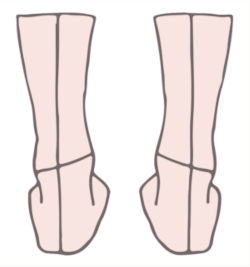
How to Know If You Have Narrow Feet
Not sure if you have narrow feet or just picky toes? Here are a few signs your feet might be slimmer than average and begging for better-fitting shoes.
Telltale Signs of Narrow Feet
- Your shoes feel like canoes. If standard-width running shoes feel loose no matter how tight you lace them, that’s a red flag.
- Blisters show up early and often. Especially around the heel or sides of your feet? Blame the extra space.
- Your feet fatigue faster. Loose (and heavier) shoes make your feet work harder to stay stable, leading to soreness or fatigue way too soon.
- You double-sock just to fill space. If you’ve turned to sock-stuffing strategies, it’s time for a proper fit.
How to Measure Your Foot Width at Home
No fancy tools needed, just paper, a pen, and a ruler:
- Trace your foot while standing (even pressure = accurate results).
- Measure the widest part across the ball of your foot.
- Use a shoe width chart to compare your width to standard sizing. If you’re consistently below average for your shoe size, congrats: you’re in the narrow club.
Understanding Shoe Widths
Running shoe widths aren’t universal, but here’s the usual shorthand:
Women’s Widths:
- AA = Narrow
- B = Standard
- D = Wide
Men’s Widths:
- B = Narrow
- D = Standard
- 2E = Wide
So if you’re a woman who finds B-width shoes too roomy, try AA. Men drowning in D-width? B might be your new best friend.
What to Look for in Running Shoes for Narrow Feet
If you have narrow feet, the search for the right running shoe starts with fit, not flashy colors. Begin with standard-sized shoes that naturally run slim, especially those with a snug midfoot, a secure heel, and solid arch support. Think of it like finding jeans that actually fit your waist and don’t sag at the back—rare, but worth it. Steer clear of budget shoes; they often skip the tech your feet need, like structured support or better foam. And while laceless running shoes might look sleek (and save you 5 seconds), skip them if you want a truly dialed-in fit. You can’t tighten what doesn’t lace.
The Best Running Shoes for Narrow Feet (2025 Picks)
Here’s a list of the best running shoes for narrow feet (in no particular order):
Brooks Ghost 17
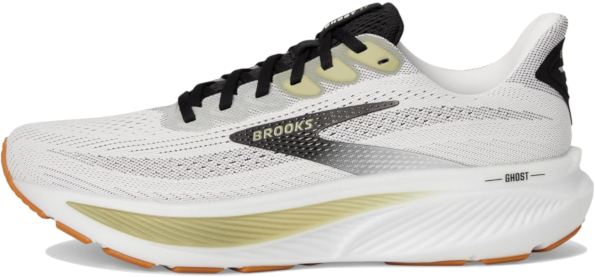
Tech details:
- Support: Neutral
- Heel-to-toe Drop: 10 mm
- Stack height: 36.5/26.5 mm
- Weight: 9.0 oz women / 10.1 oz men
The Brooks Ghost 17 is a snug-fitting neutral shoe that doesn’t mess around. It hugs the foot a bit more than the Ghost 16, thanks to a tighter fit and a more supportive engineered air mesh upper. If you’ve been craving more cushioning up front, good news: Brooks added 3 mm under the forefoot, bringing it to 26.5 mm. Paired with a 10 mm drop, improved heel bevel, and a touch more toe stack, transitions feel smoother than ever.
No, it doesn’t have the fancy DNA Tuned foam from the Glycerin 22, but the DNA Loft v3 midsole still delivers reliable, stable cushioning mile after mile. It’s a touch heavier than last year’s model, but that extra weight comes with upgrades you’ll actually notice. In short: the Ghost 17 may not be flashy, but it’s quietly better in all the right ways.
SHOP AT ZAPPOSSaucony Tempus 2
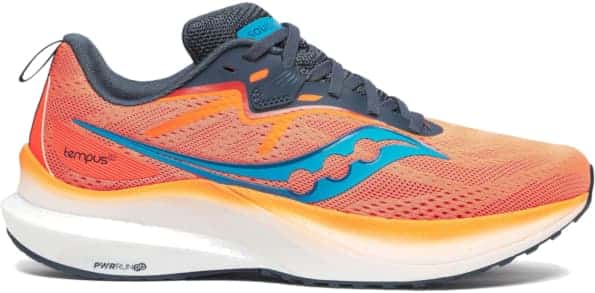
Tech details:
- Support: Stable
- Heel-to-toe Drop: 8 mm
- Stack height: 33/25 mm
- Weight: 8.2 oz women / 9.4 oz men
The Saucony Tempus 2 is what happens when a stability shoe drinks espresso and decides to go fast. It’s lighter than the Guide 18 by 5.6 grams (not that anyone’s counting… except we are) and handles tempo runs like it was built for them, which it basically was. The fit? Snug. Especially through the midfoot. If you’ve got regular or wide feet, it might feel like the shoe is giving your foot a firm handshake. But the toe box still leaves enough room to wiggle your ambitions.
Runners with narrow feet tend to click instantly with the Tempus 2, and overpronators in particular have found their match. The PWRRUN PB foam brings a lively, responsive ride with just enough firmness to keep you in line. It’s not as bouncy as Saucony’s PWRRUN HG (the wild child of the family), but it’s the same superfoam used in their race-day shoes, which says a lot. Fast, stable, and a little unapologetic, just like your next PR attempt.
SHOP AT ZAPPOSSaucony Endorphin Speed 4
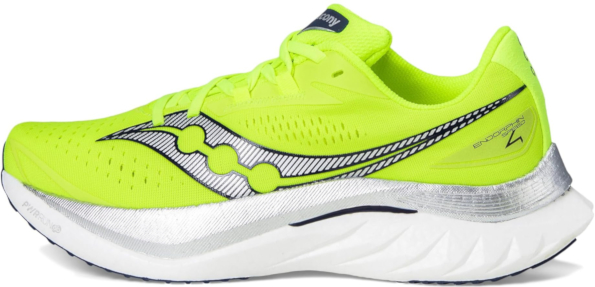
Tech details:
- Support:
- Heel-to-toe Drop: 8 mm
- Stack height: 36/28 mm
- Weight: 7.2 oz women / 8.2 oz men
The Saucony Endorphin Speed hit its fifth iteration on July 1, 2025, but don’t count out the Speed 4 just yet. You can still snag it online, often at a discount, and for narrow-footed runners, it’s still a gem. The Speed 4 runs slimmer than the Speed 5, though the toe box offers enough room to avoid toe tantrums. And while the Speed 5 may have the glow-up looks, not much has changed under the hood.
The Endorphin Speed line is Saucony’s budget-friendly answer to race-day performance. Instead of a full carbon plate, it uses SPEEDROLL tech to keep you gliding forward with less effort (and fewer grimaces). The midsole is packed with 100% PWRRUN PB; plenty lively, even if it lacks the extra bounce of the PWRRUN HG found in the pricier Endorphin Pro 4. Bonus: the Speed 4 handles easy and steady runs just fine, making it a solid pick whether you’re chasing PRs or just trying to outrun your to-do list.
SHOP AT ZAPPOSHoka Mach 6
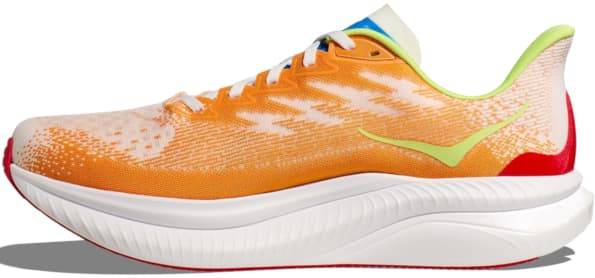
Tech details:
- Support: Neutral
- Heel-to-toe Drop: 5 mm
- Stack height: 37/32 mm
- Weight: 6.7 oz women / 8.2 oz men
The Hoka Mach 6 is a performance trainer that feels just right if you’ve got narrow feet; it’s like a firm handshake, not a bear hug. Underfoot, it features Hoka’s supercritical foam midsole, which delivers a snappy, aggressive ride that makes picking up the pace feel almost too easy. Despite its high stack, it’s impressively lightweight; lighter, in fact, than some shoes with less foam. Go figure.
Durability? Also classic Hoka. You can rack up serious mileage in the Mach 6 without watching the outsole disintegrate like a pastry on pavement. As a neutral shoe, it quietly offers structure where you need it—think sculpted sidewalls around the heel and forefoot, plus a beveled heel that subtly reins in overpronation without going full stability mode.
The 5 mm drop gives you more forefoot cushion, which your toes will thank you for around mile ten. Add in the smooth MetaRocker geometry, and the ride rolls forward effortlessly, less pounding, more flowing. It’s like cruise control for your stride, minus the button.
SHOP AT ZAPPOSNew Balance Fresh Foam X 860v14
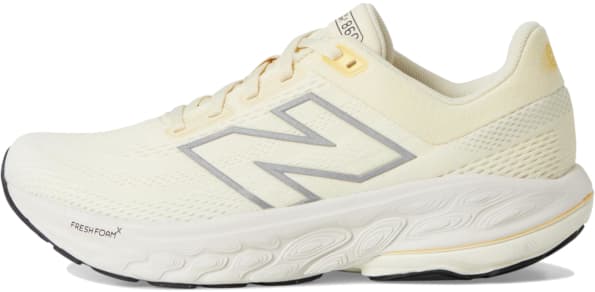
Tech details:
- Support: Stable
- Heel-to-toe Drop: 8 mm
- Stack height: 38/30 mm
- Weight: 8.7 oz women / 10.8 oz men
The New Balance Fresh Foam X 860v14 is a stability shoe that means business, and it’s not afraid to hug your foot to prove it. Even if you wear a medium width, expect a snug fit through the midfoot, though the roomy toe box lets your toes breathe (and maybe throw a tiny dance party). If the standard fit still feels too wide, don’t worry. New Balance offers a narrow width too (2A for women, B for men).
Built for runners with moderate to severe overpronation, the 860v14 uses its Fresh Foam X midsole to strike that rare balance between plush cushioning and firm support. The ride is smooth, the rebound is decent, and the stability is dependable. The structured mesh upper also locks you in like it’s trying to stop your foot from making any bad decisions. Breathability? Fine unless you’re running in a heatwave. Then again, who isn’t questioning life choices in a heatwave?
If you’re just a mild overpronator, you might find the support a bit much, like using a sledgehammer to crack a nut. Still, we think this shoe could drop a little weight in the next version without losing its backbone. Fingers crossed the 860v15 shows up with less heft and a bit more speed.
SHOP AT ZAPPOSTips for Getting the Right Fit
Give the narrow-specific models above a spin; your feet will thank you later. We’ll keep updating this list as more slim-fit gems hit the market. Also worth watching: the growing trend of unisex (or all-gender) running shoes. These aren’t just rebranded men’s shoes; they’re built for comfort, versatility, and a wide fit range that actually makes sense. Once you find the one, don’t go sprinting out the door on Day 1. Break them in gradually so your feet can get cozy before the real miles begin.
Best Running Shoes for Narrow Feet FAQs
Are narrow shoes better for performance?
Yes, for narrow-footed runners, a properly fitting shoe is nothing short of a lifesaver. A snug, secure fit means no sliding, no toe jamming, and no mid-run blister meltdowns. It’s not just about comfort, it’s about protecting your feet from future drama: think pain, deformities, and those lovely corns and calluses nobody asked for. In short, the right narrow shoe keeps your feet happy, healthy, and far less grumpy.
Can I wear standard shoes with narrow feet?
Yes, some standard-size running shoes naturally run narrow, and for narrow-footed runners, that’s great news. The trick is knowing what to look for: a slim fit through the midfoot, a heel that stays put (no slipping allowed), and arch support that doesn’t phone it in. It’s like dating for your feet; you’re looking for the right match, not just the most popular option.
What brands offer narrow-width options?
If your feet are on the slim side, don’t worry; you’ve got options. Popular brands that cater to narrow-footed runners include New Balance (the width king), Brooks (the snug-fit specialist), ASICS (for structured support), and Saucony (for sleek performance). Even Nike and Hoka get honorable mentions, while they don’t always label narrow widths, some of their shoes run naturally slim.
Final Thoughts on the Best Running Shoes for Narrow Feet
The best running shoes for narrow feet do more than just fit; they help prevent slipping, blisters, and foot pain that can bench your running dreams faster than a rolled ankle. If you don’t already have a go-to brand, don’t panic; this is your excuse to play the field. Start with the brands we mentioned above and see who wins your feet over. And here’s a pro tip: the right shoe should feel good from the start. If you’re trying to “break them in,” but they’re already breaking you, it’s not the one.
Disclosure: This page has affiliate links. When you buy through them, we earn a little something, at zero extra cost to you. Think of it as your way of tipping us for our excellent taste. (This content was created with the help of AI.)
See also:
